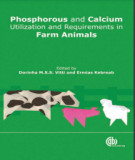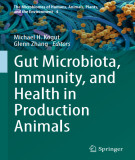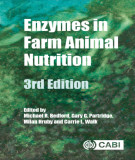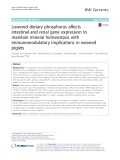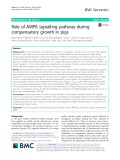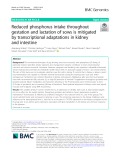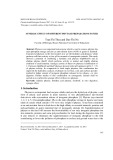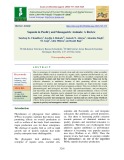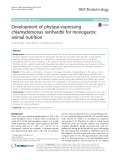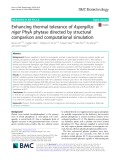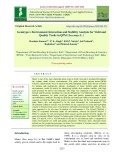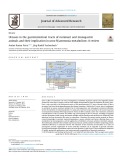
Monogastric animals
-
Part 1 book "Phosphorus and calcium utilization and requirements in farm animals" includes content: General introduction; isotope dilution technique; kinetic models for the study of phosphorus metabolism in ruminants and monogastrics; phosphorus and calcium utilization in ruminants using isotope dilution technique; phosphorus and calcium utilization in non ruminants using isotope dilution technique.
 86p
86p  muasambanhan06
muasambanhan06
 03-02-2024
03-02-2024
 9
9
 1
1
 Download
Download
-
Part 1 book "Gut microbiota, immunity, and health in production animals" includes content: Managing intestinal health in farm animals - a critical view; gastrointestinal tract barrier efficiency - function and threats; enzymes and gut health in monogastric animals - effects beyond digestibility; butyrate and intestinal homeostasis - effects on the intestinal microbiota and epithelial hypoxia; gut microbiome and poultry health; the gut mycobiome and animal health,... and other contents.
 184p
184p  muasambanhan04
muasambanhan04
 07-01-2024
07-01-2024
 4
4
 1
1
 Download
Download
-
Part 1 book "Enzymes in farm animal nutrition" includes content: The feed enzyme market in 2020 and beyond; feed enzymes - enzymology, biochemistry, and production on an industrial scale; xylanases and cellulases - relevance in monogastric nutrition – pigs, xylanases, β-glucanases and cellulases - their relevance in poultry nutrition; phytases - biochemistry, enzymology and characteristics relevant to animal feed use,... and other contents.
 135p
135p  oursky07
oursky07
 23-10-2023
23-10-2023
 10
10
 3
3
 Download
Download
-
In monogastric animals, phosphorus (P) homeostasis is maintained by regulating intestinal absorption, bone mobilization, and renal excretion. Since P is a non-renewable resource, a shortage is imminent due to widespread over-usage in the farming and animal husbandry industries. As a consequence, P efficiency should be improved in pig production. We sought to characterize the transcriptional response in re−/absorbing and excreting tissues in pigs to diets varying in calcium: phosphorus ratios.
 11p
11p  vilarryellison
vilarryellison
 29-10-2021
29-10-2021
 5
5
 1
1
 Download
Download
-
The molecular basis of compensatory growth in monogastric animals has not yet been fully explored. Herewith, in this study we aim to determine changes in the pig skeletal muscle transcriptome profile during compensatory growth following a feed restriction period.
 12p
12p  vitzuyu2711
vitzuyu2711
 29-09-2021
29-09-2021
 12
12
 1
1
 Download
Download
-
The environmental impact of pig farming need to be reduced, with phosphorus (P) being of particular interest. Specified dietary regimens and management systems contribute to meet environmental concerns and reduce economic constrains.
 11p
11p  vijeeni2711
vijeeni2711
 30-06-2021
30-06-2021
 10
10
 1
1
 Download
Download
-
In comparison to both single phytases, this combination has improved the hydrolytic catalysis of phytate in rice bran, corn and soybean powder; resulted in higher amount of inorganic phosphate released in two phases – in vitro digestion. Further studies of this combination on monogastric animals shall be carried on to confirm the synergic effect of these two phytases.
 10p
10p  tamynhan9
tamynhan9
 02-12-2020
02-12-2020
 9
9
 2
2
 Download
Download
-
Due to awareness of consumers towards clean and safe meat availability, plant secondary metabolites (PSMs) such as essential oils, organic acids, saponins and flavonoids etc. are rapidly gaining attention since last few decades. PSMs are the secondary compounds that are produced by plants and they don’t have primary role as nutrients. These can be the effective alternative to antibiotics because of their promising effects on overall performance of poultry and monogastric animals. Saponins are high molecular weight glycosides which are able to form foam in aqueous solution.
 8p
8p  trinhthamhodang5
trinhthamhodang5
 16-05-2020
16-05-2020
 15
15
 1
1
 Download
Download
-
In plant-derived animal feedstuffs, nearly 80 % of the total phosphorus content is stored as phytate. However, phytate is poorly digested by monogastric animals such as poultry, swine and fish, as they lack the hydrolytic enzyme phytase; hence it is regarded as a nutritionally inactive compound from a phosphate bioavailability point of view.
 7p
7p  viuchiha2711
viuchiha2711
 21-04-2020
21-04-2020
 17
17
 0
0
 Download
Download
-
Phytase supplied in feeds for monogastric animals is important for improving nutrient uptake and reducing phosphorous pollution. High-thermostability phytases are particularly desirable due to their ability to withstand transient high temperatures during feed pelleting procedures.
 8p
8p  vihamax2711
vihamax2711
 21-04-2020
21-04-2020
 16
16
 0
0
 Download
Download
-
Maize is one of the most important grain crops in South Asia and is produced throughout the country under diverse environments. The grain of quality protein maize (QPM) varieties contain nearly twice as much lysine and tryptophan, amino acids that are essential for humans and monogastric animals. Evaluation of maize hybrids under different environments would be useful for identifying hybrids that combine stability with high yield potential for diverse environments.
 11p
11p  nguaconbaynhay3
nguaconbaynhay3
 07-02-2020
07-02-2020
 15
15
 0
0
 Download
Download
-
Urea in diets of ruminants has been investigated to substitute expensive animal and vegetable protein sources for more than a century, and has been widely incorporated in diets of ruminants for many years. Urea is also recycled to the fermentative parts of the gastrointestinal (GI) tracts through saliva or direct secretory flux from blood depending upon the dietary situations. Within the GI tracts, urea is hydrolyzed to ammonia by urease enzymes produced by GI microorganisms and subsequent ammonia utilization serves the synthesis of microbial protein.
 12p
12p  trinhthamhodang1
trinhthamhodang1
 14-11-2019
14-11-2019
 13
13
 0
0
 Download
Download
CHỦ ĐỀ BẠN MUỐN TÌM








